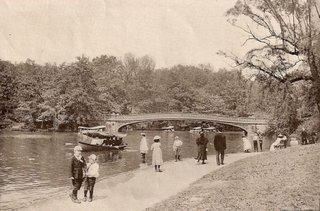 In contrast to major European cities in the early nineteenth century, New York City had no large open-air recreational grounds. City-dwellers of the time regularly drove to nearby large cemeteries to escape the noise and bustle of the City. Greenwood Cemetery in the adjacent city of Brooklyn was New Yorkers' such escape, until the amount of gravesites increased sufficiently enough to interfere with recreational activities. In fact, large cemeteries were regular "tourist attractions" for visitors to any city!
In contrast to major European cities in the early nineteenth century, New York City had no large open-air recreational grounds. City-dwellers of the time regularly drove to nearby large cemeteries to escape the noise and bustle of the City. Greenwood Cemetery in the adjacent city of Brooklyn was New Yorkers' such escape, until the amount of gravesites increased sufficiently enough to interfere with recreational activities. In fact, large cemeteries were regular "tourist attractions" for visitors to any city!By 1851, the Mayor of New York, Ambrose C. Kingsland, called the Common Council's attention of the need to "ventilate" the city. The idea rapidly gained popularity among the city-dwellers, and numerous plans for a "Central Park" were submitted by landscape architects. The park was to be situated between fifty-seventh and one hundred tenth streets, between Fifth and Eighth Avenues. By far the best plan was submitted by Frederick Law Olmsted, who owned a farm on Staten Island, and Calvert Vaux, an Englishman by birth. Their plan, submitted in 1858, which was eventually carried out, outshone the other plans in several ways. First, the carriage drives and footpaths were situated well within the borders of the park, so that the adjacent city could not be seen by those attempting to escape it. Second, carriage drives, footpaths, and bridle paths were all made to be separate, so as to avoid accidents. There was even a "speed limit" to the carriage drives! Third, a number of East-West streets were cleverly inserted into the Park, well below the eye-level and earshot of park visitors, enabling the city's business to continue unabated. The park's ground was originally rocky and barren, necessitating filling in soil, planting trees, and digging out artificial ponds. Elegant bridges, made of stone, brick and iron, were designed to connect all the park's paths.
Unfortunately, the city's streets had to be "cleared of its scattered population of squatters," in order for the park to be built. The new park took 20 years to complete, due to the nature of the terrain and numerous political squabbles originating from Tammany Hall's control.
See also: www.centralparknyc.org
Photo: Central Park: Bow Bridge and the Lake. Note the conspicuous absence of a skyline! From: "King's New York Views," 1897. Photo by Loeffler, 1895.
References: "Central Park." Unknown author. Munsey's Magazine, 1873, p 523-539.
No comments:
Post a Comment